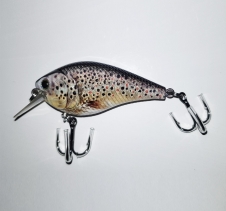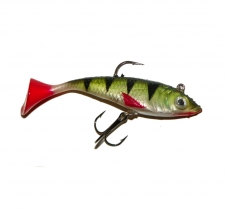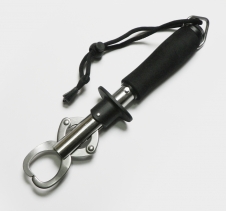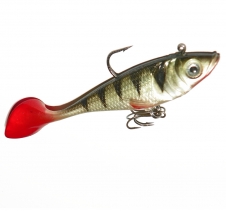Visit Our Online Store! $7 AusPost Parcel Post Delivery FREE Postage for orders $45 and over!
* Shipping rates above apply to Australian Customers only
How to use lipless hard body crank baits
We explain how to use lipless crank baits for people who are unfamiliar with this type of fishing lure.
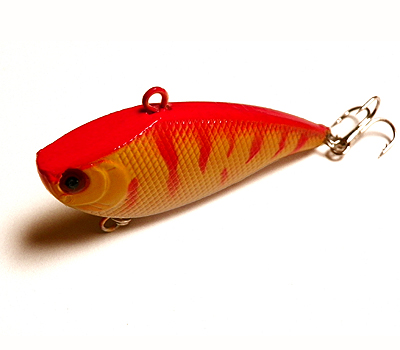 Lipless crank-baits are some of the most versatile hard-bodied baits. They can be used in just about any depth of water and are great for enticing reaction strikes from fish. Lipless crank baits are also a great way to cover a lot of water quickly. When trying to lure fish on a given body of water, using fishing lures which allows the angler to cover a lot of water quickly, and at various depths, is a great tactic.
Lipless crank-baits are some of the most versatile hard-bodied baits. They can be used in just about any depth of water and are great for enticing reaction strikes from fish. Lipless crank baits are also a great way to cover a lot of water quickly. When trying to lure fish on a given body of water, using fishing lures which allows the angler to cover a lot of water quickly, and at various depths, is a great tactic. That's one of the reasons lipless crank baits are so popular with anglers. Another reason is that, straight up, they catch fish. They catch fish during any season, even when in the winter when the water temps dip to the 4 degree Celsius mark or lower.
Water Depth
One of the great things about a lipless crank-bait is that it allows the angler to fish varying depths without changing baits. Most diving hard body crank-baits run at a certain depth, and it is difficult to get them to dive much deeper in most circumstances.
This is not the case with a lipless crank bait. Of course, as with any bait, it will run higher in the water column when using a floating line such as mono-filament and deeper when using fluorocarbon line. But, for the most part, an angler can reach any depth needed for most fishing situations. Lipless crank baits can cast a great distance. After casting, the angler simply counts down the lure. Most lipless crank baits, as a rule, will fall one foot per second. Count out ten seconds, and the lure is about 10 feet deep. The faster the retrieve the higher the bait will come into the water column, so keep a slow-roll retrieve to keep the lure down as far as possible.
Retrieves
Varying the retrieve of a lipless crank bait can help an angler catch more fish. Of course, the most basic of retrieves is the steady retrieve. This consists of throwing the bait out as far as possible and then cranking it slowly back in. At times the angler will want to keep in contact with the bottom and at other times keep it at a certain depth in the water. Some anglers target suspending fish by keeping the lure up in the water column. When fishing a lipless crank bait along the bottom, the aim is to make it look like either a bait fish is scanning the bottom for food, or to make it look like a startled yabbie, with fast sudden movements away from danger. These effects will depend on the colour of the lure too, but it is very effective in many situations.
Varying the retrieve with an occasional pause may draw more strikes, too. When the angler pauses a lipless crank bait for a second or two, it will lightly sink down in the water column. That slow sink can attract fish on its own. The same can be said for a quick snap of the rod tip. Anything that will make the lure look more like an injured bait fish can attract strikes that an angler would have otherwise missed. It is important to pay attention to exactly what was happening when the fish hit so that the angler can repeat that exact movement repeatedly while moving around the lake.
Many anglers also vertically jig lipless crank baits. This involves snapping the rod tip up and letting the bait fall on a slack line. Lipless crank baits have a very tight wiggle rather than the wider wobble of other types of crank baits. This can give fish the idea that the bait is actually a slowly dying bait fish. The sudden rise of the fishing rod will draw attention to the bait, and draw fish in the region to hit it. This is an especially good presentation for the colder months when the angler finds a school of fish below the boat.
Colour Choices
Colour can be very important when choosing a lipless crank-bait, but there is no need for an angler to have 30 different colour lipless crank baits to start out with. Anglers should think about the types of natural fish, yabbies and shrimp that are in the lake they are going to fish.
If the fish are feeding primarily on crayfish / yabbies, then similar colours to those in the waterway will work well for most of the year. It all depends on the stage the yabbies are in, and what type of yabbies / crayfish they are.
Depending on which state you are fishing in, the crayfish / yabbies in the water could be anything from the grey to blue colour found in the lower east, to green, red or orange in other areas. As the crayfish / yabbies age, they shed their shell multiple times to reveal a different colour each time, you will need to match a similar (and in darker waters, brighter) colour to mimic their progression. In some cases yabbies may even appear black.
The easiest way to choose a colour is to throw an opera house yabbie net into the water, with a small piece of raw chicken attached. Leave it for 30 minutes and then remove to see whether yabbies are present, and if they are, you can then decide the most effective colours that may work best in that waterway.
In the case of mimicking a bait fish, colour is important as well. If the fish are feeding on flathead gudgeons primarily, a light brown or green imitation may work great. If there are galaxias, baby trout, baby redfin, juvennile carp or rainbowfish, then anglers should try to match the natural colours of the fish.
Remember most times in waters without high visibility, you will often need to go a little brighter than the natural fish colours for this method to be effective.
If you do not have time to try and catch some minnows by swiping a landing net or placing a bait trap, then black and gold seems to work well in many lakes, as does white and black or white and blue, silver with a black top (green stained waters), or silver with a blue top (in clear water only, when the surface appears blue) are also very popular all rounders.
While it's important to keep colour in mind, anglers should be aware that often times the bite elicited by a lipless crank bait is a reaction strike. Dimpled lipless crank baits in flashy colours such as gold and silver emit a flash that can look like an injured bait fish. This will draw a game fish in quickly, as it looks like an easy meal.
As a general rule of thumb, flashier baits and white baits work better in darker water. Bright colours always work well, too. And, of course, in clear water, more natural colours are best. Lure scents may be added to a lipless crank-bait at any time. Some anglers believe this helps keep the fish holding on to the bait longer, giving the angler more time to set the hook.
Gear
A trout rod or any rod with a very low lure cast weight rating (4 grams or less), are perfect for lipless crank baits, just as they are for other hard body lures. This low cast weight adds precision to casting low weight lures, allowing the angler to cast the bait very far, with enough rod strength to get the fish to the boat.
Line choice is up to the angler. Mono-filament and fluorocarbon are the most popular. 12 - 14 lb. test is probably more than enough. Anglers should keep in mind, though, that mono floats and fluoro sinks. This will make a difference in the retrieve. A 5.1:1 to 5.4:1 bait casting reel is ideal for this technique. It will allow the angler to get the fish to the boat without being so fast that it creates problems on the retrieve.
Conclusion
Lipless crank-baits are a great option for most anglers. They are very versatile. In most cases, they allow the angler to cover the entire water column without changing baits. They are great for covering a large amount of water quickly when finding fish.
Anglers can vary the retrieve method in almost endless ways. Colour is important in lipless crank baits, but so is flash (reflection of gold, silver, yellow or white).
Anglers should 'match the hatch' as closely as possible to their target species, to ensure a good clean hook up and lower the chances of a missed catch.
Follow us on twitter: @FishTackleLures or Google Plus: +FishingTackleLuresAU
View more articles in our Australian Fishing Guide.
Enter your email address below to be updated on new fishing articles, fishing lures and special offers:
We will only email once every two to four weeks at the most, usually every 2 months.
POPULAR PRODUCTS IN OUR ONLINE STORE


